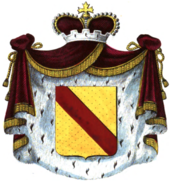House of Ligne
 |
|
| Ethnicity | Belgian |
|---|---|
| Current region | Belgium |
| Place of origin | Ligne in Belgium |
| Distinctions | Princes de Ligne |
| Estate | Château de Belœil |
| Princely Family of Ligne |
|---|
Extended family
|
HI&RH Archduchess Yolande of Austria
HH Princess Maria
The House of Ligne is one of the oldest Belgian noble families, dating back to the eleventh century. The family's name comes from the village in which it originated, between Ath and Tournai.
The lords of Ligne belonged to the entourage of the Count of Hainaut at the time of the Crusades. With the battle of Bouvines in 1214, they were described as "great name and men of honour" by the chroniclers of the time.
Their progressive rise in the nobility began as barons in the twelfth century, counts of Fauquemberg and princes of Épinoy in the sixteenth century, then princes of Amblise in 1608. The family became Imperial counts on 18 December 1544, then Lamoral I received from Emperor Rudolf II the title of Prince of the Holy Roman Empire as Prince de Ligne on 20 March 1601, for all of his agnatic descendants, both male and female.
Compensation for loss of the Imperial County of Ligne (Fagnolles, since that barony had become seat of the county in 1789) as a result of the Peace of Lunéville consisted of substitution of the secularized Imperial abbey of Edelstetten, with an individual vote guaranteed in the Imperial College of Princes in 1803. That principality was, however, sold to Prince Nikolaus Esterházy on 22 May 1804, before the abolition of the Holy Roman Empire, of which Edelstetten had been a constituent Imperial state, in 1806.
...
Wikipedia

